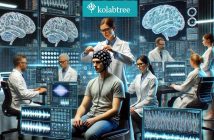Dr. Souvick Chatterjee, the Director of External Relations in the Postdoctoral Association of the University of Illinois at Chicago offers a recipe to a successful academia-industry collaboration.
It is nice to think of any collaboration as a marriage — and academia-industry コラボレーション is no different. Just like a relationship goes through different phases, a collaboration does as well. It goes through the dating (networking) phase, the proposal, and the wedding (official contract). The steps involved in finding the right laboratory or scientist for your business, or finding the right industrial partner for your lab is remarkably similar to the steps involved in finding a partner! Here’s an outline of the steps involved in academia-industry collaborations.
1. The First Meeting
There are high possibilities of the existence of a third-party agent to facilitate the first meeting in a partnership. The first meeting usually take places in academic and/or business conferences. When the academic’s goal is to collaborate with industries it is crucial to identify the right conference. Chances of finding the right partner is slim if academicians try to find industry partner in an academic-focused conference. Conferences also involve a huge amount of money and time and can be a drain on your resources. An alternative to conferences are platforms like コラブツリー (think of this as online dating!), which help academia find peers they can collaborate with, and businesses they can offer their services to. Digital networking removes the geographical, financial and administrative restrictions that come with attending conferences.
After the skills match happens, it’s important to play the next step right. It is imperative to ask the right questions. For example, can the problem in the industry space be solved by laboratory expertise? There are many industries who are looking to outsource some of their requirements in the form of freelancing and consulting. For industries that need the expertise of a scientist for short-term projects, recruiting from online freelancing platforms is a good option. When the industry is looking at long-term research partnerships, they often turn to universities and academic institutions. An academic laboratory with motivated students and developed infrastructure can always be the frontrunner in proposing a solution for the problem the industry partner trying to overcome. The University of Cambridge, for example, partners with several companies such as ExxonMobil and AstraZeneca for innovative research.
2. The Proposal
A good proposal is one that the other partner cannot refuse. That is only possible if the proposal is of substance. Hence, the proposal must show some value in the research strategy. This value can be of any form (knowledge, money, novelty) which is of relevance for the exact problem the industry partner is trying to overcome. Also, before the proposal, it is better to go out on some dates (have Skype conversations/face-to-face meetings) to discuss requirements, expectations, deliverables and limitations. Sounds familiar?
A key limitation academic partners face is balancing fundamental and applied research. However, if the goal is towards innovation, if looked top-down, most applied researches can have a fundamental counterpart. Finding the right combination is like finding the right ingredient in a successful relationship. In early 2018, Google announced its partnership with the Technical University of Munich. The partnership meant that while Google will tap into the academic expertise offered by the university in 人工知能, 機械学習 and robotics, it would offer a $1 million donation to the University to further research.
3. The Marriage
The marriage follows the standard proceedings — signing of Non-Disclosure Agreements, Terms of Conditions etc. After that comes the hardest part: having the responsibility to continue the relationship as long as possible. It is crucial to ensure the relationship does not run out of steam! The only way the partnership can be made sustainable is to avoid saturation and constantly thrive for novelty. While this might be hard, there can be multiple ways to deal with this based on specific cases. But, the endeavor to keep the spark ignited is a key ingredient.
Having said that, all good things do come to an end — and collaboration agreements are often signed for a specific period of time. And yes, having multiple partners is allowed here and is not considered cheating! Novartis has 300+ academic collaborations with institutions all over the world.
My experiences with academia-industry collaboration has been a good learning experience. Currently I am a post-doctoral research associate in the Micro/Nanoscale Fluid Transport Laboratory headed by Prof. Constantine Megaridis in the Department of Mechanical and Industrial Engineering, University of Illinois at Chicago. We have industry partners from both startups as well as Fortune 500 companies. While the third party agent for introducing our laboratory to the respective companies is a water harvesting conference for the former, for the latter, it is the Nonwovens Institute based in North Carolina. In this context, I believe an online platform like コラブツリー can be immensely powerful in bringing problems and solutions closer in this fast-paced innovation ecosystem.
Our collaboration with the Kimberly-Clark Corporation (Fortune 500 Company) has yielded fruitful results for more than 7 years now. The interesting thing about academia is that professors and projects grow old, but students never grow old. There is constant inflow and outflow of students and postdocs in the laboratories which has its own pros and cons. However, going beyond these resource issues, the collaboration has yielded multiple patents, journal publications and PhD thesis. The company provided us information about challenges they were looking to solve and we tried to come up with innovative solutions within on the physical constraints existing in the problem. The experience an academic lab can achieve in this exposure is immense and goes beyond the intellectual benefits. Soft skills like communication, presentation and networking are enriched, which is always helpful in any sphere of professional career.
It is my pleasure to serve as the Director of External Relations in the Postdoctoral Association of University of Illinois at Chicago, where one of our main objectives is to promote academia-industry nexus. We’ve arranged a panel discussion with a professor, an entrepreneur and a consultant — all of whom were able to offer something of value to the other person from their own experiences. I’d also like to mention a nonprofit well-known for promoting academia-industry partnerships, CHIentist who arrange multiple workshops to promote Tech Transfer and Commercialization. These events always remind me of Akira Kurosawa’s Rashomon effect: that every individual’s perspective is different and is based on their own experiences and way of “institutionalization”. We all live in our own bubble and the more it expand our horizon, chances of breaking the bubble is more increasing the chances of opening our mind. Here’s to opening up our boundaries and strengthening our collaborations, which will then bring about innovation!







